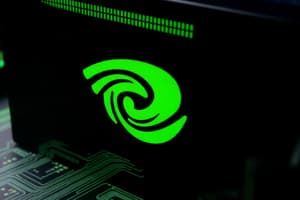Podcast
Questions and Answers
Which tool can be used to visualize the timeline when profiling CUDA code with nvprof?
Which tool can be used to visualize the timeline when profiling CUDA code with nvprof?
- TensorBoard
- NVIDIA Visual Profiler (nvvp) (correct)
- Jupyter Notebook
- PyTorch Profiler
What is the purpose of using the emit_nvtx context manager?
What is the purpose of using the emit_nvtx context manager?
- To load nvprof results in Python REPL
- To annotate nvprof traces for inspection (correct)
- To force nvprof to flush the collected data to disk
- To automatically generate NVTX ranges
What information does emit_nvtx append to the ranges it generates?
What information does emit_nvtx append to the ranges it generates?
- Timestamp information
- Memory usage information
- Function call information
- Sequence number information (correct)
Which type of ranges are useful for correlating Function objects with the earlier forward pass?
Which type of ranges are useful for correlating Function objects with the earlier forward pass?
When does each function's execution during backward become useful?
When does each function's execution during backward become useful?
What is the relationship between backward and double-backward?
What is the relationship between backward and double-backward?
Which tool can be used to visualize the timeline when profiling CUDA code with nvprof?
Which tool can be used to visualize the timeline when profiling CUDA code with nvprof?
What is the purpose of using the emit_nvtx context manager?
What is the purpose of using the emit_nvtx context manager?
What information does emit_nvtx append to the ranges it generates?
What information does emit_nvtx append to the ranges it generates?
When does each function's execution during backward become useful?
When does each function's execution during backward become useful?
What is the relationship between backward and double-backward?
What is the relationship between backward and double-backward?
What is the purpose of using torch.autograd.profiler.load_nvprof()?
What is the purpose of using torch.autograd.profiler.load_nvprof()?
What does the emit_nvtx context manager do when running the program under nvprof?
What does the emit_nvtx context manager do when running the program under nvprof?
Which type of ranges are useful for correlating Function objects with the earlier forward pass?
Which type of ranges are useful for correlating Function objects with the earlier forward pass?
What is the purpose of using create_graph=False during default backward?
What is the purpose of using create_graph=False during default backward?
During CUDA profiling, why is it necessary to use the emit_nvtx context manager?
During CUDA profiling, why is it necessary to use the emit_nvtx context manager?
Which type of ranges are useful for correlating Function objects with the earlier forward pass?
Which type of ranges are useful for correlating Function objects with the earlier forward pass?
What is the purpose of using the emit_nvtx context manager?
What is the purpose of using the emit_nvtx context manager?
When does each function's execution during backward become useful?
When does each function's execution during backward become useful?
What is the relationship between backward and double-backward?
What is the relationship between backward and double-backward?
What information is given to each function's execution during backward if a backward pass with create_graph=True is underway?
What information is given to each function's execution during backward if a backward pass with create_graph=True is underway?
What can functions in the backward pass do during double-backward?
What can functions in the backward pass do during double-backward?
What do Function objects' ranges in double-backward have?
What do Function objects' ranges in double-backward have?
What is the purpose of using create_graph=True during a backward pass?
What is the purpose of using create_graph=True during a backward pass?
What is emitted by the functions during double-backward?
What is emitted by the functions during double-backward?
What can be compared to sequence numbers from the backward pass during double-backward?
What can be compared to sequence numbers from the backward pass during double-backward?
Flashcards are hidden until you start studying
Study Notes
Profiling CUDA Code with Nvprof
- The tool used to visualize the timeline when profiling CUDA code with nvprof is Nsight Systems.
Purpose of Emit_Nvtx Context Manager
- The emit_nvtx context manager is used to generate ranges that correlate Function objects with the earlier forward pass.
- The emit_nvtx context manager appends sequence numbers and device/data transfer information to the ranges it generates.
Backward and Double-Backward
- Each function's execution during backward becomes useful when a backward pass with create_graph=True is underway.
- The relationship between backward and double-backward is that double-backward is a pass that occurs when the gradients of gradients are computed.
- During double-backward, functions can recreate the computation graph and compute the gradients of gradients.
- Function objects' ranges in double-backward have sequence numbers that can be compared to sequence numbers from the backward pass.
Creating Graphs and Profiling
- The purpose of using create_graph=False during default backward is to prevent the creation of a computation graph.
- The purpose of using create_graph=True during a backward pass is to create a computation graph.
- The emit_nvtx context manager is necessary during CUDA profiling to generate ranges that correlate Function objects with the earlier forward pass.
- torch.autograd.profiler.load_nvprof() is used to load the profiling results from nvprof.
Studying That Suits You
Use AI to generate personalized quizzes and flashcards to suit your learning preferences.




